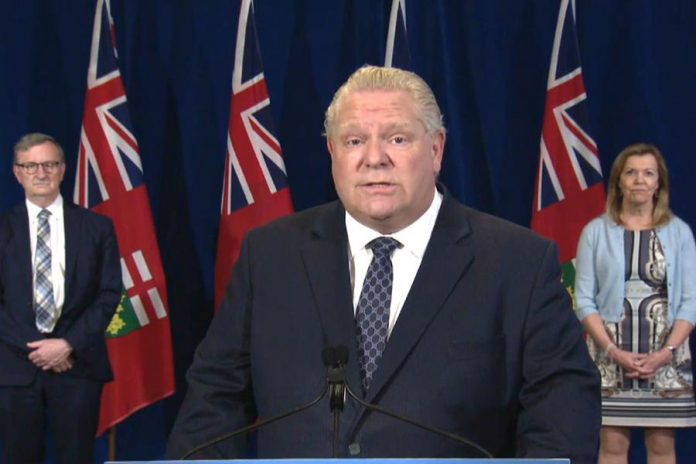
The Ontario government announced on Friday (May 29) that COVID-19 testing will now be available to more people in more locations across the province, and that the government is now considering a regional approach as it continues to reopen the province.
Premier Doug Ford made the comments during a media briefing at Queen’s Park where he announced the next phase of the government’s COVID-19 testing strategy, along with health minister Christine Elliott and Ontario’s chief medical officer of health Dr. David Williams.
He first described the expanded COVID-19 testing to date, including proactive testing of hospital staff, long-term care residents and staff, correctional workers and inmates, and essential workers, as well as vulnerable populations and the staff who care for them in group homes, shelters, emergency child care centres, and other congregate settings.
Ford also encouraged all Ontarians who want a test to get one.
“If you have COVID-19 symptoms, if you’re worried you’ve been in contact with someone with COVID-19, if you or your family are worried about exposure — in short, if you feel you need a test — please, please go get a test. You will not be turned away.”
He said the expanded testing will result in finding more COVID-19 cases, but that is necessary to more quickly contain the spread of the virus and to complete contact tracing.
“We can’t manage what we can’t measure,” he explained. “The more people we test, the more contacts we can trace. We have an army of 2,000 contact tracers in the field right now following up on cases. We need to keep increasing that capacity. More testing will also help us better understand the trends.”
Ford said expanded testing is already providing the government with a clearer picture of what each region in the province is dealing with, and where public health measures are needed most.
“That is why I am now comfortable with asking our officials to look at a regional approach for staged reopening. This will be one option we consider as we move into stage two.”
Ford added that the government is only able to consider this option now “because we’re getting our testing to where we need it”. He said health officials are currently looking at what a regional model could look like.
“I know other jurisdictions have used this regional approach,” Ford said. “I want to look at how this has gone in other areas, what lessons we can learn.”
Several reporters at Friday’s media briefing questioned how a regional approach would be implemented, including how the government would control for people travelling between regions.
Both Ford and chief medical officer of health Dr. Williams did not provide specifics, only saying that various factors and questions would need to be considered.
When asked by a reporter about whether a regional approach would affect the timing of stage two reopening, health minister Elliott said the stage two timing would depend on an evaluation of the impact of stage one reopenings.
Elliott, who said Ontario has entered the “post-peak phase” of its fight against COVID-19, also outlined the next phase of the government’s COVID-19 testing plan, which includes three branches:
- Expanding who can get tested at the 129 COVID-19 assessment centres across the province, to include people who are asymptomatic (showing no symptoms) but who are concerned about exposure to the virus.
- Detecting and containing COVID-19 cases by expanding surveillance for vulnerable populations who are not showing symptoms, including in long-term care homes and other shared living spaces like shelters and group homes, as well as targeted testing of workplaces in priority sectors, particularly those where it may be difficult to physically distance.
- Reserve testing capacity to ensure a rapid response to COVID-19 outbreaks, including in specific neighbourhoods and regions, or hospitals and workplaces. This will include the rapid and agile deployment of mobile testing teams.
“Combined, this significant expansion of testing will provide valuable information about the spread of the virus in different communities across the province,” Elliott said. “We will continue to learn from this data and adjust or adapt as needed to ensure we continue to protect all Ontarians.”
Earlier on Friday morning, Ontario public health officials provided a technical briefing on Ontario’s enhanced testing strategy. A copy of that presentation is provided below.
PDF: Protecting Ontarians through Enhanced Testing
Protecting Ontarians through Enhanced Testing


























